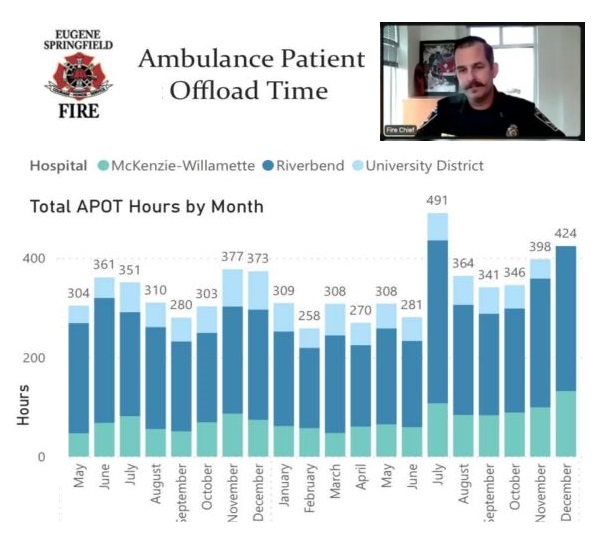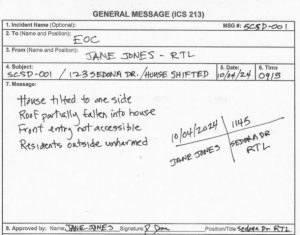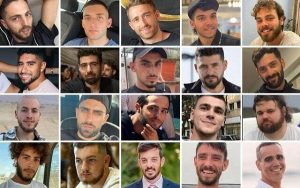Fire chief offers first look at ice storm response, impact of hospital closure
12 min read
The city of Eugene responds to the ice storm. At the city council Jan. 24:
Mike Caven (Chief, Eugene Springfield Fire): ESF (Eugene Springfield Fire) was incredibly busy out on the front end of this call. We saw an incredible spike in call volume. Basically on an average week, we respond to anywhere between 850 and 1,000 calls. Last week we caught 1,664 calls for 3,000 unit dispatches.
Our busiest day was 608 unit dispatches on (Jan.) 15. We transported almost 600 people, 241 fire calls from fire responses, and 19 CO responses or carbon monoxide from generators, things like that. The majority of those were in Springfield, the carbon monoxide, because they had such extended power outages, challenges like that.
[00:00:50] For us here at Fire—despite some very unfortunate events south of us in the Cottage Grove area, where I believe that the second person died from a house fire last week. which was their second fatal house fire and a number of other storm-related deaths—we haven’t gotten any reports of specific, directly storm-related deaths in our response area, which speaks a lot to our community’s ability to care for themselves.
[00:01:15] When we think about who we’re serving, especially at our warming centers or Egan and those as we think about the after-action discussions and reports, it’s important to not forget those warming centers and respite centers. You know, a lot of people just like, ‘Well, you know, we’re helping get the unhoused out of the elements.’
[00:01:33] The reality is, in a storm like this, it’s everybody. It’s our family members, it’s our elderly populations, our disabled populations, everybody that needs extra help and no way to get out or get to those places or get to their medications. It’s a very diverse population, and we’re already working, Chief (JoAnna) Kamppi, our EMS chief, sat on a meeting with, today, Department of Emergency Management, California, talking about access to emergency, access to all of our disaster plans, like, because we have something, does that mean everybody can get to it? And if not, how do we get to them?
[00:02:11] And so, this storm will teach us a lot as we move forward and plan for caring for our community where they are in the ways that they need cared for. But throughout this event, we did stand up two extra squads, an extra ambulance, and a battalion chief in Dispatch to help us mitigate calls to catch the additional call volumes.
[00:02:30] Despite that work, at one point, I think the highest threshold of calls pending (that we had no resources to answer) was 38. And the battalion chiefs help sort out, like, is this something that needs a response and there’s somebody else that can care for that? But most importantly is, as a resource would become available, going through that list of calls and saying which one has the most dire need to respond.
[00:02:52] As I mentioned earlier, as we think about going forward and, you know, the fact of how busy our fire department’s gotten without adding staffing and being out on a daily basis, just sunny and nice and warm. Now imagine adding 600 calls in that week to care for. So if we run out of resources normally, this storm had a big impact.
[00:03:13] I want to shout out to our crews who did an amazing job. Nobody had any significant time loss injuries with no significant vehicle damage, despite, as we’ve celebrated early access to people in this career, a lot of young folks driving ambulances. They did a great job.
In addition to that, the people you don’t see, Public Works and folks that are out there clearing streets for us, helping us get places, the sanders, the fleet team that came in and worked 24 hours a day, not only helped keep us going in the city of Eugene, they actually helped some of our units in Springfield in the middle of the night, get up and get going again when they had some mechanical failures.
[00:03:51] And so there was a lot that went into this. There was a lot of our communities in particular on the other side of the freeway in Springfield where our vulnerable folks who are normal people, they’re our neighbors who needed help, needed movement to respite centers and things like that, that’s really shown the need for our work, our planning, and future planning to make sure that that we’re ready to meet that.
[00:04:17] So, all in all, the Fire Department did a great job. The staff that were out there doing the work, we were busy. We made it through it. We dodged some bullets here and in Eugene, from what we saw the city of Springfield experience.
[00:04:32] Councilor Jennifer Yeh: I’m particularly interested in how we did, how some of our partners did as well around, especially around like food insecurity. I know that a lot of folks, it doesn’t take long before they’re out of food and going out in an ice storm, depending on where they live, was probably impossible, right?
[00:04:49] I mean, that’s not a city service, that’s often our partners that are doing that, but it would be nice to know how that happens.
[00:04:56] John Q: The executive in charge of the city’s unhoused response:
[00:05:01] Matt Rodrigues (Director, Public Works): I appreciate that, Councilor Yeh. I think there is, that’s something that I can coordinate with the city’s emergency manager. She is probably, you know, lead and in more of the whole community picture conversations that would be able to bring back information as we, you know, go through our after-action debriefs and hear of the gaps and the things we want to think about differently moving forward. So I can talk with her about that.
[00:05:28] John Q: Since the city’s only hospital closed, the fire department is getting more service calls downtown. They’re averaging 100 drug overdose calls every month.
[00:05:38] Mike Caven (Chief, Eugene Springfield Fire): Obviously, at the front of mind is the University District hospital closure. The ER did formally close on Dec. 1. The urgent care from West Eugene moved into downtown at the same time.
[00:05:52] What we saw in December was our overall call volume down 9% system-wide, but in the downtown core, Station 1’s response area (where University Hospital is), they actually saw a 5% increase in service volume. And so, as far as patterns go, people were accessing 911 more in the downtown core than they had been in the rest of the city, and so we didn’t see that that relief in overall calls.
[00:06:22] I’m going to move on to APOT, which are the Ambulance Patient Offload Times. As you recall, really, for years, it’s been a problem for us and, we were promised that moving the staff from University District to RiverBend was going to create capacity, more nurses, more availability, more rooms, more patient flow.
[00:06:46] We started implementing a fee for the APOT time in this fiscal year. And at the end of December, we issued our second quarterly bill to the hospitals. And the total amount charged for APOT times was $336,000 in the third quarter of calendar year ’23 and the fourth quarter was $337,000. And so, what we haven’t seen is an improvement in that space.
[00:07:14] And that comes with a lot of coordination with our EMS field supervisors in helping navigate patients and flow in the hospital getting people out, getting rooms for our folks. We have tremendous wait times in our emergency rooms, but they’re overwhelmed.
[00:07:29] Overall, yes, there’s been a system impact (from closing the University District hospital). It hasn’t been incredibly catastrophic to our ability to meet the community’s needs. However, it has been problematic for sure.
[00:07:43] So what are we doing about it? Last time we visited you all we were talking about the IGR (intergovernmental relations) support plan. Rep. (Nancy) Nathanson, Mayor (Lucy) Vinis, and a number of other community stakeholders, Manager (Sarah) Medary, and Assistant City Manager (Kristie) Hammitt, we all participated in some group sessions thinking about, what are the community’s needs, what are the county’s needs, and we’ve been advocating all along that we knew we would need some transport capacity.
[00:08:09] And we need help funding alternative options for the 911 system.
[00:08:13] Chief (Chris) Heppel did a tremendous amount of work on this with Rep. Nathanson, (Intergovernmental Relations Manager) Ethan (Nelson), and then in coordination with Lane County to make sure that in the innovation fund that it’s clear what it’s asking for.
[00:08:25] The second biggest ask that we had in this process was the community response, that being the two-person squad concept where you have two people who are able to deal with people’s access to care needs and more kind of intensive, how do we help them navigate the system? How do we get them to the right places? Because we have a lot of users of the hospital system. In Health and Human Services, we began to refer to those as ‘the friendly faces.’ So it’s the group of community members whose needs aren’t being met. And so they’re accessing the more critical or emergency access systems far more frequently. And so they would be able to help navigate in that space.
[00:09:06] And I just wanted to share with you all, as we wrapped up 2023 and we’re going through our statistics, we pretty much averaged well over 100 calls for overdoses per month. And an average of 35 of those or more every month resulted in somebody’s death. We’re seeing it play out every single month in this overdose crisis. And these are people’s family members, people they care about. So we’re glad that everybody’s taking this serious.
[00:09:34] Councilor Emily Semple: You get 100 calls per month, and of those, 35 people die?
[00:09:41] Mike Caven (Chief, Eugene Springfield Fire): Yep. More than 100 often. Up to 140, 150, but the average is over 100. And then, yeah, average of 35 people or more die of them.
[00:09:50] Councilor Emily Semple: So basically every day somebody dies from overdose? (Correct.) And do those happen while they’re still with you or do they get to the hospital and die?
[00:10:02] Mike Caven (Eugene Springfield Fire): Most all overdose deaths are beyond help when we arrive. So we have all the tools to bring people out of the overdose. And so does the community has access to those tools now as well…
[00:10:13] Goals for 2024: We’re working through our divisions and making sure that the titles of what we do fit our mission set; thinking about the fire marshal’s office and the fact that they have a big role in community resilience.
[00:10:27] One of the big ones we’re excited for is leveraging some CSI investment (Community Safety Initiative) in wildfire planning and fuels mitigation. So we’ll be appointing a wildfire planning and fuels mitigation manager here and providing a materials and services budget to help with fuels reduction.
[00:10:45] And so, that’s going to be, I think, a big noticeable impact to our community because those are processes that we haven’t really been able to tackle with our current staffing.
[00:10:53] What we’re learning through the Western Fire Chiefs and some work through Oregon State University is the traditional ‘send out a flyer or do a TV ad,’ those are not effective ways to discuss evacuation planning, fuels reduction work, the type of really community risk reduction or resilience planning that this position will be responsible for.
[00:11:15] And their task list will be helping work with the neighborhood organizations in our highest threat areas to determine what their needs are, what their education needs are, and really build and develop a top-tier plan here at Eugene Springfield Fire.
[00:11:31] There’s another component of the program or other funding source that we’re pursuing right now. It will also hopefully bring a public information officer into the fire department that will be teamed up with at this position as well.
[00:11:43] The recently retired chief from Jackson County Fire District 3 (which surrounds a lot of the Medford area), he’s leading the effort with the Western Fire Chiefs and working with Oregon State University in cataloging the programs that are working well and aren’t working well, not just in Oregon but in the Western region, really modeling off Boulder, Colorado has a really great wildfire planning and mitigation program.
[00:12:08] That’s an all-in effort, multiple legs of that stool—the fire department’s role, the city’s role, the county’s role, and then the citizens’ role in accessing the available tools to reduce the risk of wildfire around their home in their neighborhood.
[00:12:22] Mechanisms for fuels reduction, whether it’s, you know, chipper days or sites where people can take their fuels to leveraging off of a number of departments in the Portland metro area that are offering similar services, basically grants. You can rent a chipper yourself. There’s a number of ways that we’re going to be able to leverage those dollars based on our community needs assessment.
[00:12:46] Councilor Matt Keating: Here in the South Hills and through our neighborhood association in particular, there’s been a lot of education, awareness, community-led ladders of communication when it comes to mitigation. It’s great work.
[00:13:05] Councilor Alan Zelenka: On the wildfire planning, fuels mitigation work: I think that’s super critical. We shouldn’t forget last summer, especially, wildfires within the urban growth boundary in the Laurel Hill Valley area was pretty frightening for a lot of people. I could stand on my property over there and see the fire. That’s never happened before. So we shouldn’t lose sight of how important that is. And it’s going to become, unfortunately, with climate change, more and more of a common thing and a bigger and bigger deal. So the faster we can do that, the more resources we can put into that, and the more education we can do with with homeowners and property owners, the better off we’re going to be. Really important work. Glad you’re doing it.
[00:13:52] Mike Caven (Eugene Springfield Fire): Yeah, we agree. Last year in the Moon Mountain Fire, I mean, that’s the biggest, biggest and highest threat fire that we’ve experienced in the urban interface environment in our service area. We got lucky. And when we think about the fact, especially in the middle of, the heat of the day like that, it’s often that we don’t have very many fire resources that are already committed to other calls. So that’s why I focused on, also, how do we increase our ability to staff and do that work. So we’re looking forward to leveraging that planning.
[00:14:25] Councilor Lyndsie Leech: I’m getting a lot of communication from constituents, particularly in the Whiteaker, about warming fires and the response times—or lack of response to some of those that feel dangerous to people. Like, if they’re against a building or they’re left unattended or under tree cover: Could you remind us of the protocol and what to do if, like, there’s nobody to be able to respond because everybody is already busier on other calls.
[00:14:57] Mike Caven (Eugene Springfield Fire): Yeah, so, when we’re not in fire season, we don’t respond to what are termed ‘illegal burning complaints.’ Those are often the warming fires, those types of things. However, any fire threatening a building or posing any kind of community risk should get a response from (Eugene Springfield) Fire.
[00:15:15] So for those constituents that we didn’t respond, it’s important that we know if that’s the case or not. When we’ve checked into some others, they weren’t up against the building, they weren’t posing a threat.
[00:15:27] We understand the feeling that folks have, but at the same time, it’s this challenging space when people are struggling to survive and it’s not posing a threat to spreading. And then the other is if those fires are unattended, that should initiate a response from Fire to go manage that and put it out.
[00:15:46] John Q: Eugene Springfield Fire reports calls are up downtown, they’re seeing one drug overdose death every day, and early figures show that since PeaceHealth closed Eugene’s only hospital, ambulances are travelling farther, and not returning to service any faster. The fire chief says it’s ‘problematic.’



